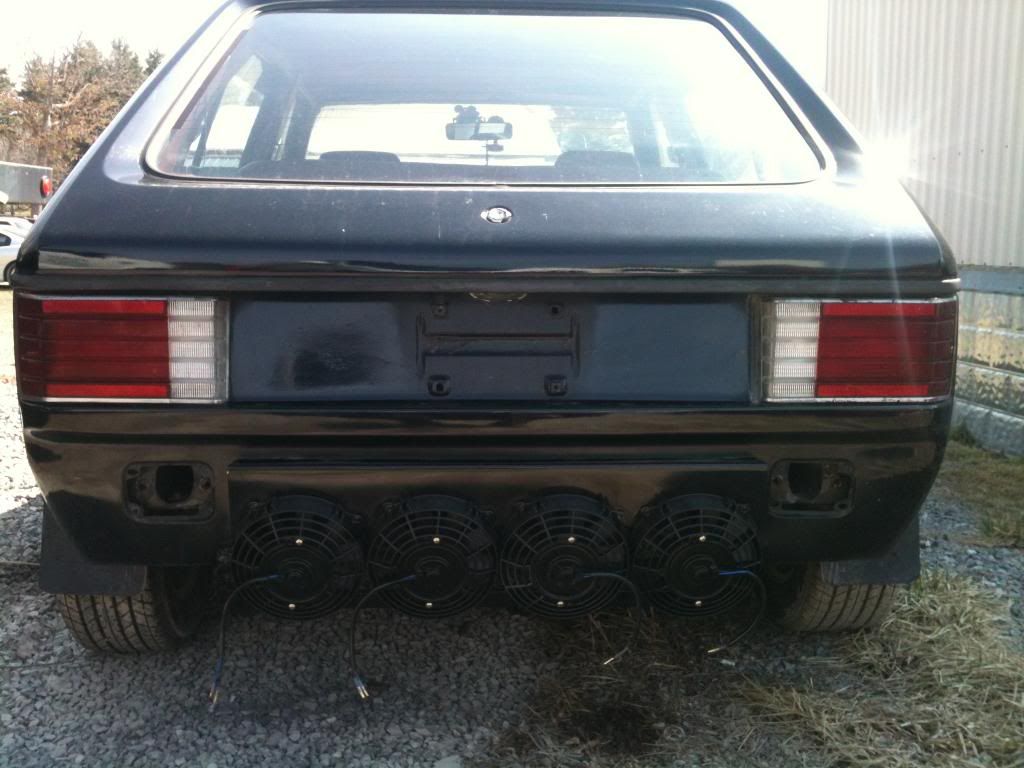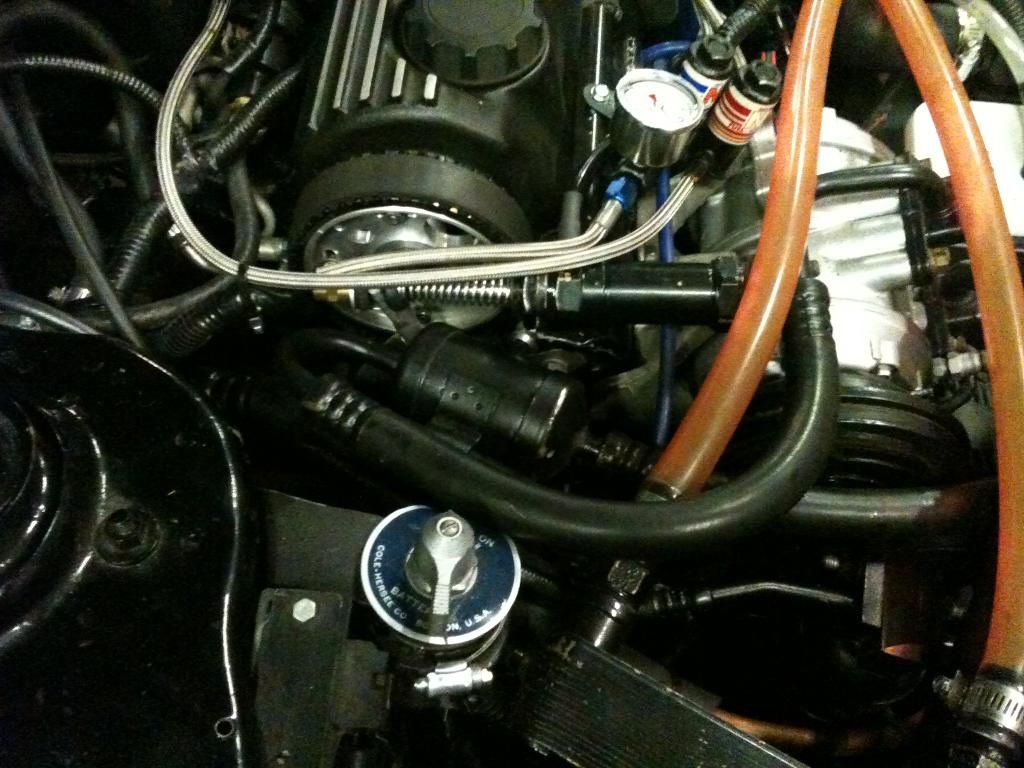Are you the guy that messed around with Mitsubishi's in Cowen.... Wouldn't happen to be you would it?
Are you the guy that messed around with Mitsubishi's in Cowen.... Wouldn't happen to be you would it?
Leafy wrote:RossD wrote: FINALLY! Someone that has used the car's A/C system to provide cooling to their intercooler! I've thought about this soooooo many times but have never found anyone that has done it!There was a kit for the cobalt SS/SC, made less power than the stock air to water intercooler. The small gain from having colder air did offset the power draw from the compressor. The VVT is interesting.Welcome!
My assumption is that it wouldn't work as well on S/C cars due to the higher temps produced by roots blowers compared to a turbocharger or centrifugal supercharger. I'd guess a big factor would be the size of the reservoir.
RGL10 wrote: Not much to tell really. The system is very simple. If you have any questions I will try to answer them. I just cut the low pressure - suction hose between the evaporator and compressor and put the heat exchanger in. Any a/c shop that can make hoses can do it. The freon that is returning to the compressor can still absorb a lot of heat even after it cools the interior of the car. It does strain the condenser somewhat so I run two fans on mine, one pusher and one puller. The car has no heat soak problem like most intercoolers, the longer it idles the better the intercooler works! On a 70 degree day I've measured the intercooler water tank at 25 degrees. I don't think any other kind of intercooler can match an a/c cooled system.
Where is the heat exchanger from? Looks very similar to the RX performance kits made for ZL1's.
There is no draw from the compressor when you accelerate because the clutch is disabled when the throttle is opened more than 3/4 of the way. Also the way water to air intercoolers work when its cold outside removes the need to cool the water with the a/c. Here is why, lets say its 40 degrees outside, for one thing you really don't even need an intercooler with that kind of ambient air unless you can hold the car in boost for extended periods of time (like over a minute). So far I've never been able to do that here in WV. The car will hit 120 in less than 20 seconds and redline in high gear with the 2.60 final drive in less than 40 seconds so I cannot run it hard enough in cold weather to really heat up the intake air at 20 psi boost. Another reason you don't need the a/c to cool the water in the winter is because the incoming air cools the water as it passes through the intercooler at idle and normal driving. Its kinda like the intercooler turns into a heat exchanger under non boost conditions cooling the water down to ambient temperature, say 40 degrees. The water pump runs all the time so all 2 gallons of water will get down to 40 during normal driving with the a/c off. Then when I go into boost the water will absorb any heat the turbo makes from compressing the air to 20 psi and the process starts over again as soon as I back off the pedal. Also if all else fails to cool the water in the winter you can turn on the defroster and the a/c compressor will run some and definitely cool it down lol. Hope this is not too confusing an explanation. If it is feel free to tell me and I will try to explain it better.
beans wrote:
Where is the heat exchanger from? Looks very similar to the RX performance kits made for ZL1's.
Its just a generic plate type heat exchanger from ebay. I watched till I got one for 25 dollars.

dansxr2 wrote: Are you the guy that messed around with Mitsubishi's in Cowen.... Wouldn't happen to be you would it?
Uh if you are talking about 25 plus years ago and a couple of Dodge Colt turbos then yes lol.
Add me to the "Impressed" audience! May I ask, in your opinion, would a water to air intercooler work for street / autocross / HPDE applications IF the A/C was not part of the equation? How about at lower boost levels? Compared to an air-to-air intercooler.
I believe the biggest bonus of a liquid to air isthat heatsoak isn't as big of an issue and you can cool air in a smaller, more compact exchanger. I've considered swapping the intercooler setup on my MR2 to an ST205 Liquid to Air, but haven't convinced myself it'd be much of a benefit in my current use of the vehicle.
In reply to RGL10: There was a guy that worked on a lot of Mitsubishi's... My friend was gonna have him rebuild the transmission but the guy found a pinched wire and had it fixed in just a couple minutes. Lasinger I think was his last name.
I might be related since my last name is Lassinger. Yeah that would be me. Probably not many others with that last name in WV and definitely not in Webster county. I was working at the Chevrolet/Amc dealership in Summersville in 81. (I am ancient) They sent me to school on the upcoming Renault Fuego Turbo in the spring of 82. I will always remember that as it was my first drive in a turbocharged car. For me it was an amazing car. A fuel injected, intercooled, turbocharged 1.6 high tech piece of machinery. Too expensive for an 18 year old though. A year and a half later I was working at the Chrysler and then Amc dealer up the street. Chrysler released the 84 Mitsubishi Colt turbo. I bought the first one the dealership got and hotrodded it to death for a year then Chrysler released the GLH Turbo and I traded the Colt in for the Omni you see modified in this post. Sorry for the long autobiography but it kinda explains my interest in turbos and how I came to work on Mitsubishi's.
mikeatrpi wrote: Add me to the "Impressed" audience! May I ask, in your opinion, would a water to air intercooler work for street / autocross / HPDE applications IF the A/C was not part of the equation? How about at lower boost levels? Compared to an air-to-air intercooler.
Just my opinion, if I was not going to run the hybrid wta with a/c cooling I would just run an air to air. If you lack room then maybe a water to air would be necessary otherwise a good air to air is tough to beat and less likely to have problems in most applications.
Just thought I would update this thread since its been awhile. The car is back together and running. The vct system works after a few revisions. The water to air intercooler has been improved by moving the a/c condenser to the rear of the car. Here are a couple of pics. If you want to see a lot of pictures and step by step detail check out one of my build posts here- Turbo Dodge or here- Turbo-Mopar


The variable cam timing system on my car has worked well enough that I consider it a success. This winter as I upgrade the exhaust manifold and turbo I will do some cosmetic work on the vct. I suffered a few minor setbacks mostly from experimenting but that's half the fun. Originally I thought I would use air to power the actuator then I moved to oil control but with the parts I had it just was not going to work so back to air I went. I'm glad I did as there is no mess to deal with, its much faster and is a hundred times less likely to damage the engine if something fails. Its built from a bunch of common items or stuff you can get off ebay. With what I know now I could build it in one long day. I'm getting ready to park the car for the winter but I wanted a video of it in action before I did that so here it is. Too much wind noise I know but the cameras are cheap so if you listen closely you might even be able to hear the difference in the engine when the cam retards at higher rpms.
http://www.youtube.com/watch?v=GkmyXnIMjC8
You'll need to log in to post.